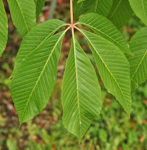
 This group of trees and shrubs tend to be large
and coarse textured with large, palmately
compound leaves. Their flowers are borne in
tall, upright clusters and can be quite
attractive when in bloom. In the fall, they
produce nuts that can be very messy in home
landscapes. This is an example of a misleading
common name since these are NOT chestnuts as in
"...chestnuts roasting on an open fire." Those
come from the genus Castenaea, the true chestnut.
This group of trees and shrubs tend to be large
and coarse textured with large, palmately
compound leaves. Their flowers are borne in
tall, upright clusters and can be quite
attractive when in bloom. In the fall, they
produce nuts that can be very messy in home
landscapes. This is an example of a misleading
common name since these are NOT chestnuts as in
"...chestnuts roasting on an open fire." Those
come from the genus Castenaea, the true chestnut.
 Actually, the nuts of the horsechestnut are
poisonous if not prepared properly. Native
Americans learned how to roasted the nuts, mash
them and leached the meal with water for several
days, after which they used the meal to make
breadstuffs.
Actually, the nuts of the horsechestnut are
poisonous if not prepared properly. Native
Americans learned how to roasted the nuts, mash
them and leached the meal with water for several
days, after which they used the meal to make
breadstuffs.
Newer cultivars of the buckeyes have been
developed to emphasize their flowers and have
been chosen for smaller size trees suitable for
the landscape.
Linnaeus
gave
this genus the Latin name used for a type of
oak that had edible nuts.



